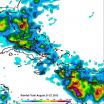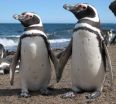(Press-News.org) NASA's Aqua satellite flew over Tropical Storm Leslie on Sept. 5 during a picture perfect moment, just as it was being re-classified as a hurricane, and captured two images of the storm.
The National Hurricane Center issued the advisory confirming Leslie's hurricane status at 1:45 p.m. EDT after examining visible, infrared, microwave and other data from satellites. Two instruments that fly aboard NASA's Aqua satellite provided infrared and visible imagery of Leslie as it was crossing the threshold from tropical storm to hurricane status on Sept. 5.
The Moderate Resolution Imaging Spectroradiometer (MODIS) instrument provided a visible image of Hurricane Leslie on Sept. 5 at 1:15 p.m. EDT as the storm was approaching Bermuda. The MODIS image showed that an eye had just formed in Leslie.
The Atmospheric Infrared Sounder (AIRS) instrument also aboard Aqua captured infrared data at the same time. The AIRS data showed the strongest thunderstorms and coldest cloud top temperatures were wrapped in a large area around the center of circulation and in a wide band of thunderstorms to the east and south of the center. Cloud top temperatures in both areas were colder than -63 Fahrenheit (-52 Celsius). On Sept. 6, the strongest convection (rising air forming the thunderstorms that make up the cyclone) and coldest cloud top temperatures were east of the center of circulation as a result of westerly wind shear.
On Sept. 6 at 8 a.m. EDT, Leslie had maximum sustained winds near 75 mph (120 kmh). The area of tropical storm force winds now extend outward up to 195 miles (315 km). Leslie's center was about 440 miles (705 km) south-southeast of Bermuda, near latitude 26.3 north and longitude 62.4 west. Leslie is slowly drifting toward the northeast near 1 mph (2 kmh) and is expected to continue drifting in that direction through Friday, Sept. 7.
Leslie continues to cause a lot of rough surf in a large area. Warnings for rough seas, swells and rip tides are in effect for Bermuda, the U.S. east coast from central Florida northward, the Northern Leeward Islands, Puerto Rico and the Virgin Islands for the next couple of days.
Leslie's slow movement continues to bring up cooler waters from below the surface of the ocean, which will be detrimental to its intensification. However, the wind shear is expected to decrease and Leslie is expected to move northward, so the National Hurricane Center expects that Leslie may intensify over the next couple of days. Leslie is forecast to pass east of Bermuda on Sunday, Sept. 9 as a hurricane.
INFORMATION:
NASA satellite captured Hurricane Leslie's picture perfect moment
2012-09-06
ELSE PRESS RELEASES FROM THIS DATE:
More grandparents fill caregiver role
2012-09-06
Grandparents, an increasingly important source of child care in the United States, vary greatly in the kind of care they provide, depending on their age, resources, and the needs of their children, research at the University of Chicago shows.
A new UChicago study, based on a National Institute on Aging survey, shows that 60 percent of grandparents provided some care for their grandchildren during a 10-year period, and 70 percent of those who did provided care for two years or more.
The results mirror recent U.S. Census data showing the importance of grandparents in ...
NASA analyzes Isaac's rainfall: Drought relief and flooding
2012-09-06
As it passed through the northern Caribbean, around south Florida, and into Louisiana and the Middle Mississippi Valley, Hurricane Isaac brought lots of rain, some of it beneficial, and some of it not. Using data from the TRMM satellite, NASA created images of rainfall totals generated along Hurricane Isaac's path.
In addition to capturing detailed images of tropical storms, the Tropical Rainfall Measuring Mission (TRMM) satellite is ideally suited to measure rainfall from space. TRMM is managed by NASA and the Japanese Space Agency, JAXA. For increased coverage, TRMM ...
Mining the blogosphere
2012-09-06
Montreal, September 6, 2012 – Can a computer "read" an online blog and understand it? Several Concordia computer scientists are helping to get closer to that goal.
Leila Kosseim, associate professor in Concordia's Faculty of Engineering and Computer Science, and a recently-graduated doctoral student, Shamima Mithun, have developed a system called BlogSum that has potentially vast applications. It allows an organization to pose a question and then find out how a large number of people talking online would respond. The system is capable of gauging things like consumer preferences ...
In Rochester, a tale of tainted tattoos
2012-09-06
If you end up with a rash on a new tattoo, you should probably think twice before brushing it off as an allergic reaction or a normal part of the healing process.
A recent study in the New England Journal of Medicine documents 19 cases in the Rochester, N.Y., area – the largest ever reported – of tattoos infected with a type of bacteria often found in tap water. Evidence points to a premixed gray ink, the type used in currently popular portrait or photography tattoos, as the culprit.
Mary Gail Mercurio, M.D., a dermatologist at the University of Rochester Medical ...
Deep-sea crabs seek food using ultraviolet vision
2012-09-06
HOLLYWOOD Fla. — Some deep-sea crabs have eyes sensitive to ultraviolet light, which they may use to snatch glowing plankton and stuff it in their mouths, a new Nova Southeastern University study suggests.
Tamara Frank, Ph.D., a marine biologist and associate professor at Nova Southeastern University's Oceanographic Center, who is the principal investigator of the study, said that crabs living the deep-sea zone --- a pitch dark area at the ocean bottom ---- may be using bioluminescence to help sort out their food.
Duke University marine biologist Sönke Johnsen. Ph.D., ...
CNIO participates in the ENCODE project: A stride forward in biomedical research
2012-09-06
The international Encode project, a collaborative study bringing together hundred of scientists from all round the world, including researchers working at the Spanish National Cancer Research Centre (CNIO), published results yesterday mapping the control and regulation of genome activity. These results indicate a total of four million 'switches' controlling the gene activity of 147 types of human cells and tissue. This map provides us with the first comprehensive vision of the genome as a complex web of interactions, and goes far beyond our initial thinking, which assigned ...
Urban Real Estate Development Firm Launches Digital Brand
2012-09-06
With the impending completion of redevelopment on 1 & 7 Ionia and another property closing in downtown Grand Rapids, Michigan, soon to be announced, urban real estate development firm 616 Development is establishing its brand in the digital space. The company's new website, 616Development.com, offers detailed insights into the company's founding, its core members, key development projects and its unique approach to urban development. Alongside engagement in prominent social networks, the website lays the foundation for the brand's voice in both digital and non-digital ...
Picky penguins: Does mate choice depend on genes that help resist disease?
2012-09-06
NEWPORT, Ore. – Magellanic penguins have a high level of variation in genes associated with the ability to fight infectious disease, but a recent study found that the mechanism the penguins use to ensure that diversity is far from black and white.
Found exclusively south of the equator in South America, Magellanic penguins assemble in large nesting colonies along the coasts of Argentina, Chile, and the Falkland Islands. They typically mate for life, producing clutches of two eggs that are cared for by both parents. While individual colonies can number in the millions ...
NFL players may be at higher risk of death from Alzheimer's and ALS
2012-09-06
MINNEAPOLIS – New research shows that professional football players may be at a higher risk of death from diseases that damage the cells in the brain, such as Alzheimer's disease and ALS (also known as Lou Gehrig's disease), compared to the general U.S. population. The study is published in the September 5, 2012, online issue of Neurology®, the medical journal of the American Academy of Neurology.
The study included 3,439 players with an average age of 57 from the National Football League with at least five playing seasons from 1959-1988. Researchers reviewed death ...
The best strategy to defeat HIV in South Africa
2012-09-06
The World Health Organization is about to roll out a new strategy for AIDS prevention in South Africa, a country where more than 5 million people are infected with HIV. Based on a mathematical model, the WHO predicts this strategy will completely eliminate HIV in South Africa within a decade.
But not so fast, suggests a group of UCLA researchers. Their work challenges the proposed strategy by showing it could lead to several million individuals developing drug-resistant strains of HIV. And further, they say, it will cost billions of dollars more than the WHO has estimated. ...



